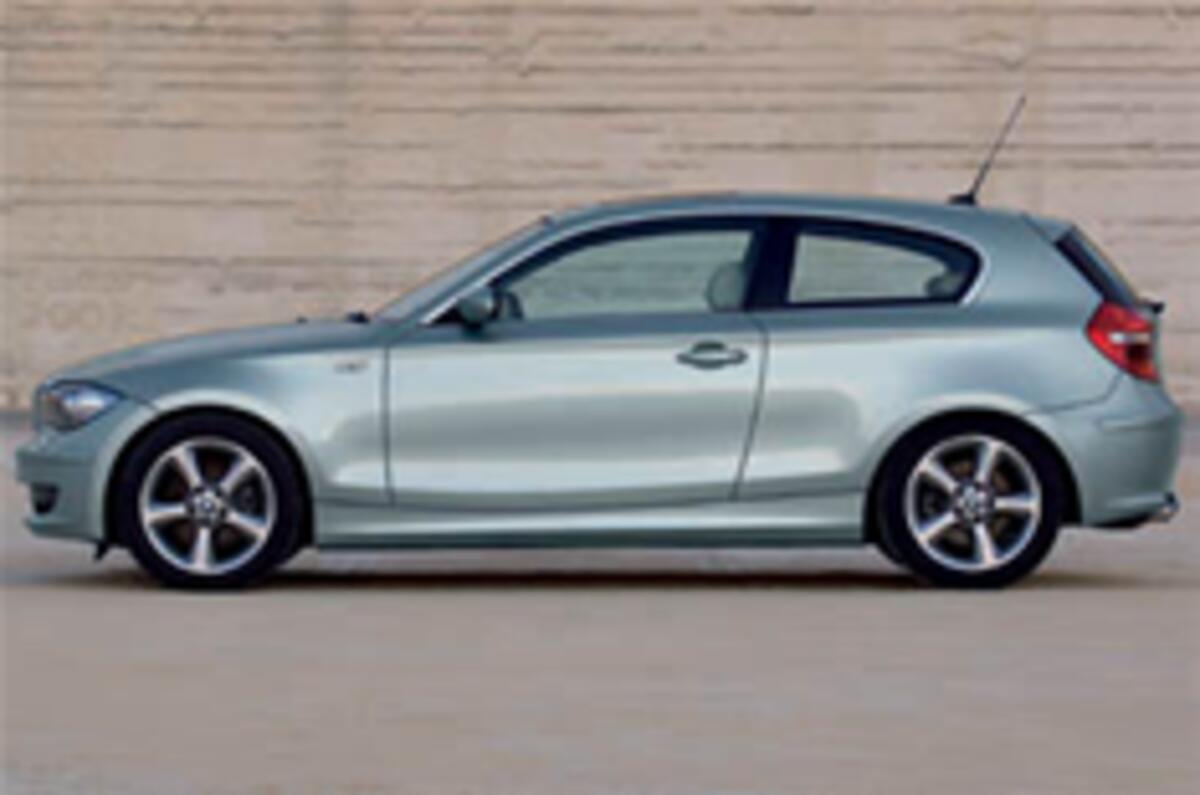BMW has added a sporty three-door model as well as a host of detailed changes to its 1-series line-up in a bid to continue the strong sales momentum built up since its introduction in 2004. The facelifted model, due in showrooms in March, is differentiated by a series of styling changes, further refining the 1-series’ edgy appearance while serving to tone down some of the more controversial aspects of Chris Bangle’s "flame surfacing".
The 1-series gets a fresh front bumper with a full-width air duct helping to emphasis the car’s width, a more prominent grille with added chrome highlights as well as revised headlamps with clear lenses and revised projector beams. The alterations to the rear are even more subtle, with only a lightly re-profiled bumper and new tail lamp graphics to set it apart from today’s two-and-a-half-year-old model.
Visually, there’s not much separating the new three-door 1-series from its five-door sibling; the two sharing the same profile, with only the length of the front doors and position of the B-pillar appearing to differ. It's the same story in dimensions, too; both share the same 4239mm length, 1934mm width and 1421mm height. They also ride on the same 2660mm wheelbase.
Super-efficient new engines
While the styling changes are subtle, there’s plenty of action underneath the bonnet of the facelifted 1-series, with the introduction of a heavily revised 2.0-litre four-cylinder petrol engine running BMW’s High Precision Injection (HPI) direct-injection system – as recently announced for the facelifted 5-series’ six-cylinder powerplants. Operating at a nominal 200bar of pressure and equipped with the latest piezo injector technology, it brings about a moderate boost in output while improving fuel efficiency to a level close to that of rival diesel engines.
In the 118i, the four-valve-per-cylinder unit produces 143bhp and 140lb ft of torque – up by 14bhp and 7lb ft respectively. The increase shaves an impressive 0.6sec off the 118's 0-62mph time at 8.8sec. Top speed is up by 1mph to 130mph. More impressive, however, is its combined cycle average fuel consumption of 47.9mpg – an improvement of over 10mpg.
In the 120i, meanwhile, the advanced new engine provides an added 20bhp and 7lb ft at 170bhp and 155lb ft. That’s sufficient for 0-62mph in 7.8sec, a 139mph top speed and 44.1mpg.
It’s not only the petrol engines that have come in for improvement. The 2.0-litre four-cylinder common rail turbodiesel has also received a series of detailed upgrades. In the 118d, the four-valve-per-cylinder unit punches out an added 21bhp and 15lb ft at 143bhp and 221lb ft.
That’s enough to lower the 0-62mph time by 1.0sec to 9.0sec and increase top speed by 6mph to 130mph. Its biggest draw, however, is the claimed combined cycle average of 60.1mph – making it the most fuel-efficient BMW road car on sale.
In the 120d, the new engine provides an extra 14bhp and 7lb ft at 177bhp and 258lb ft. This results in a 0-62mph time of just 7.6sec and a top speed of 141mph, along with a highly competitive 57.6mpg average.
The 116i’s 115bhp 1.6-litre four-cylinder and 130i’s 265bhp six-cylinder powerplants are unchanged.
Regenerative brakes
BMW has also mated all of the facelifted 1-series’ engines with a so-called Brake Energy Regeneration (BER) system. It uses a newly developed alternator that decouples under acceleration, storing energy only during overrun and braking. This, claims BMW, places less strain on the engine, results in lower fuel consumption while providing slightly increased levels of performance and helps create a more stable storage of energy. To make the most of the new system, BMW is also equipping the 1-series with a contemporary micro glass-filled battery in place of a conventional lead-acid type.
Another innovation is an optional start/stop function available on four-cylinder models in combination with the new car’s standard six-speed manual gearbox. Claimed to provide further fuel savings – particularly in congested city traffic, it automatically switches off the engine when the driver places the gearlever in neutral and deactivates the clutch. When the clutch pedal is activated again the engine fires and the driver is free to select first gear and move off.




Add your comment